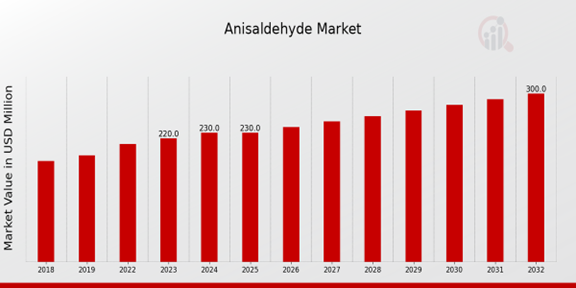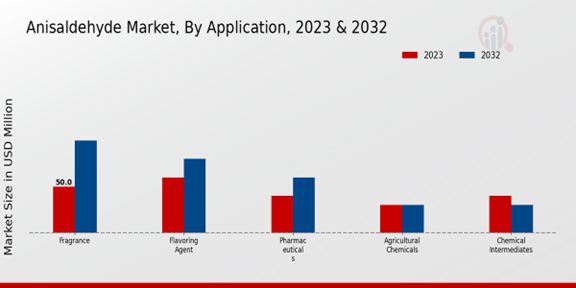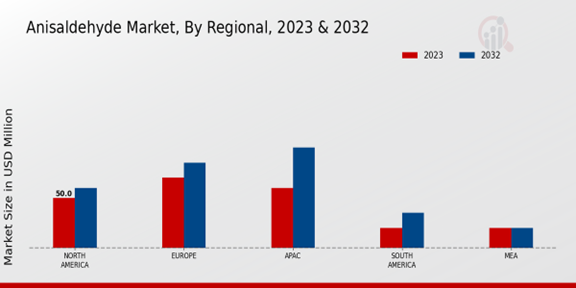Global Anisaldehyde Market Overview
The Anisaldehyde Market Size was estimated at 210.0 (USD Million) in 2022. The Anisaldehyde Industry is expected to grow from 0.22(USD Million) in 2023 to 300.0 (USD Million) by 2032. The Anisaldehyde Market CAGR (growth rate) is expected to be around 3.58% during the forecast period (2024 - 2032).
Key Anisaldehyde Market Trends Highlighted
The Anisaldehyde Market is experiencing notable growth driven by the increasing demand for this compound in various industries, such as flavors and fragrances. Its role as a flavoring agent in food and beverages, along with its use in the cosmetic and personal care industries, enhances its market appeal. Additionally, the rise in awareness regarding natural and synthetic fragrances has spurred interest in anisaldehyde as a versatile ingredient for enhancing product quality. The expanding pharmaceutical sector also presents further opportunities, with anisaldehyde being utilized in drug formulations and as an intermediate in chemical synthesis.Opportunities for growth can be captured through strategic collaborations between manufacturers and distributors to expand market reach. Emerging applications in sectors like agrochemicals and packaging materials could also prove beneficial as companies seek innovative uses for anisaldehyde. Given the ongoing trends towards sustainability and eco-friendliness, the production of anisaldehyde from renewable resources is gaining traction, aligning with consumer preferences for greener products. As regulations surrounding the use of chemicals tighten, there is an opportunity for companies that ensure quality and safety in their offerings. In recent times, the emphasis on research and development has led to advancements in synthesis and application methods, unlocking new potential for anisaldehyde in varied product formulations.The market is witnessing a shift towards customization, where manufacturers focus on tailoring anisaldehyde for specific applications in different industries. This adaptability allows businesses to respond dynamically to consumer preferences and regulatory changes. Additionally, digital marketing strategies are being leveraged to increase visibility and engagement with end-users, facilitating a direct connection and tailoring offerings to meet specific needs. The industry is poised for continued innovation, particularly as consumer demand evolves.

Source: Primary Research, Secondary Research, MRFR Database and Analyst Review
Anisaldehyde Market Drivers
Growing Applications in the Fragrance Industry
The Anisaldehyde Market Industry is witnessing a significant growth driven by the increasing demand for anisaldehyde in the fragrance sector. Anisaldehyde is a key ingredient in many perfumes and fragrances due to its sweet, floral, and pleasant aroma. This compound is primarily used to create desirable scent profiles in various personal care products, cosmetics, and home fragrances. With a growing awareness of personal grooming and the rising trend of premium fragrances, the application of anisaldehyde has expanded.Additionally, the shift towards natural and sustainable products is leading manufacturers to seek high-quality, versatile ingredients like anisaldehyde to formulate fragrances that appeal to environmentally conscious consumers. The expanding market for perfumes in emerging economies further supports the demand for anisaldehyde, as increased disposable income allows consumers to spend more on premium products. The versatility of anisaldehyde for creating diverse fragrance notes makes it a staple in the industry, ensuring its continued prominence as a key driver in the Anisaldehyde Market Industry.
Rising Demand in the Agrochemical Sector
The Anisaldehyde Market Industry is experiencing growth due to the increasing usage of anisaldehyde as a precursor in the synthesis of agrochemicals. This chemical compound is essential in the development of various pesticides and herbicides, which are crucial for ensuring food security and improving agricultural productivity. As the population continues to rise, the demand for efficient agricultural solutions grows, fuelling the need for effective agrochemicals and thereby driving the anisaldehyde market.The ongoing advancements in agricultural technology and practices further contribute to this trend as agrochemical formulations become more sophisticated. Consequently, the agrochemical industry's expansion acts as a significant driver for the Anisaldehyde Market Industry.
Increasing Use in Pharmaceutical Manufacturing
Another pivotal driver for the Anisaldehyde Market Industry is its rising application in pharmaceutical manufacturing. Anisaldehyde serves as an intermediate in synthesizing various pharmaceutical compounds and is pivotal in developing certain medications. As the pharmaceutical industry continues to innovate and expand, the necessity for high-quality chemical intermediates like anisaldehyde becomes even more critical. The increasing focus on healthcare and the demand for effective therapeutic solutions further boost the anisaldehyde market.Additionally, the growing emphasis on research and development in pharmaceuticals reinforces this market driver.
Anisaldehyde Market Segment Insights
Anisaldehyde Market Application Insights
The Anisaldehyde Market demonstrates robust potential within the Application segment, showing a comprehensive valuation structure as it caters to various sectors. In 2023, the overall market was valued at 0.22 million USD, portraying a promising trajectory towards an estimated 300.0 million USD by 2032. The market is characterized by several key applications, prominently including Fragrance, Flavoring Agent, Pharmaceuticals, Agricultural Chemicals, and Chemical Intermediates. The Fragrance application holds significant importance, with a valuation of 50.0 million USD in 2023, and is projected to rise to 100.0 million USD by 2032, reflecting its chief role in the perfume and cosmetics industry.This growing demand for fragrances emphasizes Anisaldehyde's position as a pivotal aromatic compound, catering to personal care and household products. In the Flavoring Agent capacity, the market valuation stands at 60.0 million USD in 2023, with expectations to reach 80.0 million USD by 2032. This application showcases Anisaldehyde's role in enhancing food and beverage products, a sector that continuously seeks innovative flavor profiles to meet consumer preferences. Pharmaceuticals, another key area, accounts for 40.0 million USD in 2023, with anticipated growth to 60.0 million USD, further solidifying Anisaldehyde’s value as an essential chemical in drug formulation and contributing to therapeutic efficacy.On the other hand, Agricultural Chemicals remain static with a valuation of 30.0 million USD in both years, while Chemical Intermediates start at 40.0 million USD but see a decline to 30.0 million USD by 2032. This suggests a re-evaluation of Anisaldehyde’s utility in chemical synthesis processes across various industries. As the Anisaldehyde Market continues to develop, understanding these dynamics highlights both opportunities for growth and the critical importance of each application within the broader market landscape. The market growth will be influenced by evolving regulatory standards, emerging consumer trends towards natural and organic products, and increased production capabilities driving innovation in these applications.Collectively, these factors shape the Anisaldehyde Market statistics and illustrate the ongoing demand and diversification of Anisaldehyde applications across various sectors.

Source: Primary Research, Secondary Research, MRFR Database and Analyst Review
Anisaldehyde Market End Use Industry Insights
The Anisaldehyde Market is experiencing significant growth, valued at 0.22 million USD in 2023 and projected to reach 300.0 million USD by 2032. This growth is being driven by its diverse applications across various end-use industries. In the Food and Beverage sector, Anisaldehyde is recognized for its flavoring properties, enhancing the overall consumer experience. Similarly, in the Cosmetics industry, its fragrant profile plays a crucial role in formulating personal care products, which has positioned this segment as a major contributor to market growth.The Pharmaceutical industry also relies on Anisaldehyde for its potential therapeutic benefits, making it a key ingredient in several formulations. The Agriculture sector utilizes Anisaldehyde's antifungal and antibacterial qualities, and its demand is rising as agrochemical applications expand. Lastly, the Industrial Chemicals segment represents a significant portion of the market, where Anisaldehyde serves various chemical processes, highlighting its versatility. Overall, the Anisaldehyde Market segmentation showcases a wide range of opportunities driven by the increasing demand across these industries, and the market growth reflects this diversity and importance in real-world applications.
Anisaldehyde Market Form Insights
The Anisaldehyde Market is poised for significant growth, particularly within the Form segment, which encompasses Liquid, Solid, and Powder forms. In 2023, the overall market value reached approximately 0.22 million USD, with expectations of expanding to 300.0 million USD by 2032. The growth trend within the market is supported by increasing applications in various industries, including pharmaceuticals and cosmetics, where Liquid forms tend to dominate due to their ease of formulation and versatility. The Solid form also plays a crucial role, offering stability and convenience in storage and handling.Additionally, the Powder form is finding relevance in specialized applications, particularly in the flavoring and fragrance sectors, bolstering the overall market dynamics. The market growth is further fueled by rising product demand, although challenges such as regulatory compliance and raw material availability may impact the overall landscape. A comprehensive analysis of the Anisaldehyde Market segmentation reveals diverse opportunities for stakeholders, as each form presents unique advantages suited for varying industrial requirements.
Anisaldehyde Market Purity Level Insights
In the Anisaldehyde Market, the Purity Level segment plays a crucial role in determining its overall dynamics and revenue generation, with the market valued at 0.22 million USD in 2023. The purity levels are categorized into three main ranges: Below 95%, 95%-99%, and Above 99%. Each of these categories caters to different applications in various industries, such as pharmaceuticals, fragrances, and chemicals. The segment with purity above 99% is particularly significant as it is often sought after for premium applications that require the highest quality and efficacy, making it a key driver of market growth.Conversely, the below 95% category is vital for cost-sensitive applications, holding a significant market share due to its affordability. The trend toward higher purity levels is driven by increasing regulatory standards and consumer preference for quality, while challenges such as production costs and market competition may impact growth. The overall Anisaldehyde Market statistics reflect a robust interest in purity, as stakeholders continuously seek opportunities within this segment to enhance their product portfolios and fulfill market demands.
Anisaldehyde Market Regional Insights
The Anisaldehyde Market is evolving significantly across various regions, with the market valued at 0.22 USD Million in 2023. In terms of regional segmentation, North America holds a value of 50.0 USD Million for the same year, reflecting a steady demand within the market. Europe demonstrates a stronger position with a valuation of 70.0 USD Million, indicating its significant contribution to the Anisaldehyde Market revenue. The APAC region is on a growth trajectory with a valuation of 60.0 USD Million, showcasing a rise in consumer demand and industrial applications, especially in pharmaceuticals and cosmetics.South America and MEA present lower valuations of 20.0 USD Million, yet they exhibit growth potential due to expanding industrial sectors. Notably, the European region dominates with its established industries and regulatory support, while APAC, with its burgeoning market, is becoming increasingly vital in the Anisaldehyde Market. Market growth in these regions is driven by increasing applications in various end-user industries, although challenges exist in terms of market penetration and competition. The Anisaldehyde Market statistics indicate promising opportunities, especially in regions where consumer awareness and demand for quality products continue to rise.

Source: Primary Research, Secondary Research, MRFR Database and Analyst Review
Anisaldehyde Market Key Players and Competitive Insights
The Anisaldehyde Market is witnessing a robust competitive landscape characterized by the presence of several key players focusing on innovation, product diversification, and strategic collaborations to enhance their market share. The demand for anisaldehyde is driven by its various application areas, including the production of flavors, fragrances, and pharmaceutical intermediates. This chemical compound, derived from natural sources, has garnered significant attention for its versatility and functional properties. As a result, companies are increasingly investing in research and development to enhance their product offerings and optimize production processes. Competitive strategies involve not only expanding geographical reach but also fostering partnerships that can lead to new product developments and market penetration. The presence of formidable competitors ensures that the market remains dynamic as each player continuously seeks to capitalize on emerging trends and consumer preferences.Alfa Aesar has been a significant player in the Anisaldehyde Market, known for its high-quality products and customer-centric approach. The company leverages its strong research capabilities and extensive range of chemicals to maintain a competitive edge. Alfa Aesar's strengths lie in its efficient production methods, which assure high purity levels and consistent quality, attracting customers across various industries. Their commitment to innovation has led to the development of specialized formulations suited for niche applications, which further enhances their market presence. Moreover, their established distribution networks and responsive customer service are instrumental in fostering strong relationships within the market, allowing them to meet diverse customer needs effectively.BASF is another prominent entity in the Anisaldehyde Market, recognized for its technological advancements and comprehensive portfolio. The company's extensive experience and resources enable it to produce anisaldehyde at scale while maintaining high standards of quality and safety. BASF's strengths include its focus on sustainable practices, which appeal to eco-conscious consumers and regulatory frameworks. The company's commitment to research and development drives innovation in product formulation and application, allowing it to stay ahead of the competition. This proactive approach facilitates strong partnerships with end-users, further solidifying its position within the market. BASF's presence and powerful brand reputation are key assets that contribute to its sustained success in the rapidly evolving anisaldehyde sector.
Key Companies in the Anisaldehyde Market Include
- Alfa Aesar
- BASF
- Eugenol
- Tianjin Kylin
- SABIC
- Hubei Greenhome
- Hubei Jusheng
- Cambridge Isotope Laboratories
- Xiamen Hisunny
- Tianjin Chengxin
- Jiangshan Chemical
- Shandong Wokai
- Shijiazhuang Shuanghua
- Mitsubishi Chemical
Anisaldehyde Market Industry Developments
Recent developments in the Anisaldehyde Market have highlighted significant activity among key players. Companies such as BASF and Mitsubishi Chemical are focusing on product innovation and sustainability initiatives to enhance their market presence. Meanwhile, Alfa Aesar and Jiangshan Chemical have reported steady growth in demand attributed to increasing applications in flavors, fragrances, and pharmaceuticals. The market is experiencing a surge in valuation driven by the rising need for natural and synthetic flavoring agents, pushing up the competition among both established and emerging players. In terms of mergers and acquisitions, there have been noteworthy movements, particularly with Tianjin Kylin's discussions regarding strategic partnerships aimed at expanding its manufacturing capabilities, while Hubei Jusheng has shown interest in collaboration with Cambridge Isotope Laboratories to diversify its product range. Furthermore, the market's dynamics are being influenced by environmental regulations that necessitate a shift to greener production methods. This evolving landscape underscores a collective push towards market expansion and innovation among the companies in the anisaldehyde sector.
Anisaldehyde Market Segmentation Insights
Anisaldehyde Market Application Outlook
- Fragrance
- Flavoring Agent
- Pharmaceuticals
- Agricultural Chemicals
- Chemical Intermediates
Anisaldehyde Market End Use Industry Outlook
- Food and Beverage
- Cosmetics
- Pharmaceutical
- Agriculture
- Industrial Chemicals
Anisaldehyde Market Form Outlook
Anisaldehyde Market Purity Level Outlook
- Below 95%
- 95%-99%
- Above 99%
Anisaldehyde Market Regional Outlook
- North America
- Europe
- South America
- Asia Pacific
- Middle East and Africa
| Report Attribute/Metric |
Details |
| Market Size 2022 |
210.0(USD Million) |
| Market Size 2023 |
0.22(USD Million) |
| Market Size 2032 |
300.0(USD Million) |
| Compound Annual Growth Rate (CAGR) |
3.58% (2024 - 2032) |
| Report Coverage |
Revenue Forecast, Competitive Landscape, Growth Factors, and Trends |
| Base Year |
2023 |
| Market Forecast Period |
2024 - 2032 |
| Historical Data |
2019 - 2023 |
| Market Forecast Units |
USD Million |
| Key Companies Profiled |
Alfa Aesar, BASF, Eugenol, Tianjin Kylin, SABIC, Hubei Greenhome, Hubei Jusheng, Cambridge Isotope Laboratories, Xiamen Hisunny, Tianjin Chengxin, Jiangshan Chemical, Shandong Wokai, Shijiazhuang Shuanghua, Mitsubishi Chemical |
| Segments Covered |
Application, End Use Industry, Form, Purity Level, Regional |
| Key Market Opportunities |
Increasing demand in fragrances, Growth in agrochemical applications, expanding pharmaceuticals sector, Rising natural product utilization, Emerging markets demand surge |
| Key Market Dynamics |
Rising demand in the flavors industry, increasing applications in the fragrance sector, Growth in pharmaceutical formulations, Sustainable production methods adoption, Fluctuating raw material prices |
| Countries Covered |
North America, Europe, APAC, South America, MEA |
Frequently Asked Questions (FAQ) :
The Anisaldehyde Market is expected to be valued at 300.0 million USD in 2032.
The expected CAGR for the Anisaldehyde Market from 2024 to 2032 is 3.58%.
North American region is projected to have the highest market value at 100.0 million USD in 2032.
The fragrance application is expected to hold a market value of 100.0 million USD in 2032.
Key players include BASF, Mitsubishi Chemical, and Hubei Greenhome among others.
The market value of the Anisaldehyde Market in North America was 50.0 million USD in 2023.
The flavoring agent application is expected to grow to 80.0 million USD by 2032.
The market size for agricultural chemicals is expected to remain at 30.0 million USD in 2032.
The projected market value for Europe in 2032 is 85.0 million USD.
The expected market value for chemical intermediates is projected to be 30.0 million USD in 2032.





























